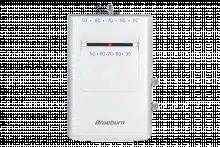Loading ...

2
2.3
Setting the Heat Anticipator
NOTE: Some heating systems require a longer or shorter “ON/OFF” period to maintain comfort.
Set the heat anticipator as specified in one of the following conditions:
• For replacement installations match the anticipator setting with that of the thermostat being replaced.
• For new installations match the current draw (amperage) of the heating control or relay. To do this check the rating
label on the control within the heating system. If the label cannot be found, determine circuit amperage by:
INSTALLATION
2
cont.
WARNING: Thermostat will not function if
anticipator handle covers PC board cutout.
1. Place system lever in the HEAT position.
2. Adjust temperature lever until indicator is at least 3 degrees above the room temperature. The heating system should start
within several seconds. Fan may not turn on immediately due to the heating system built-in fan delay.
3. Place system lever in the OFF position. The heating system should stop within several seconds.
The adjustable heat anticipator will burn out if 25 Volts are applied directly to the thermostat by shorting out the gas valve
or primary control during testing or by improper wiring.
WARNING!
TESTING YOUR NEW THERMOSTAT
3
WARNING!
Read BEFORE Testing
• Do not short (or jumper) across terminals on the gas valve or at the heating or cooling system control board to test
the thermostat installation. This could damage the thermostat and void the warranty.
• Do not select COOL mode of operation if the outside temperature is below 50° F (10° C). This could possibly
damage the controlled cooling system and may cause personal injury.
.2
.3
.4
.5
.6
.8
1.0
L
O
N
G
E
R
C
Y
C
L
E
S
1. Slide the system lever to OFF, or set temperature to lowest setting
so that the contacts are open. Make sure system power is
turned back on.
2. Set an AC ammeter to the 0 to 1 amp. range. Place the meter
probes on W and Rh terminals. The heating valve or relay will turn
“ON” and a reading will appear on the meter. Note this reading.
Remove the probes from the terminals.
3. Set the heat anticipator arrow to this meter reading. This is the
normal setting.
4. The anticipator adjustment must be made so that the thermostat
is in “balance” with the rest of the system. It will determine how
often the heating system turns on and off.
NOTE: If installing on a millivolt heat only system, set the
anticipator to the maximum setting of 1.2.
NOTE: Allow the heating system to operate for a full day or more.
Too frequent cycling of the heating system can result in lower life
expectancy for the heating system. If adjustments are necessary,
make them in 0.1 amp increments at a time. Move the anticipator
lever in direction of arrow to cycle less often.
3
5
SYMPTOM POTENTIAL SOLUTION
Thermostat does not turn
on heating or cooling
system.
Thermostat turns on
heating instead of cooling,
or cooling instead of
heating.
Check thermostat wiring to be sure that the heating and cooling stages are connected to the
correct terminals. See Installation and Wiring Diagrams sections of this manual.
Thermostat turns heating
system on too often or not
often enough.
Increase or decrease anticipator setting as appropriate to provide the desired performance
level. See Setting Heat Anticipator section of this manual.
Fan continues to run all
the time whether the
system is on or off.
Check that the fan control lever is in the AUTO position. This will allow the fan to run only
when the heating or cooling system is turned on and running.
Check thermostat wiring to make sure that the fan control wiring is connected to the correct
terminal. See Installation and Wiring Diagrams sections of this manual.
Check to see if system lever is in the OFF position. This indicates that the system is turned
OFF at the thermostat. Move the system lever to either the HEAT or COOL position.
Heating or cooling system may be malfunctioning. Call a professional service technician
immediately to verify system operation.
TESTING YOUR NEW THERMOSTAT
3
cont.
4. Place system lever in the COOL position.
5. Adjust temperature lever until indicator is at least 3 degrees lower than room temperature. The cooling system should
start within several seconds.
6. Place system lever in the OFF position. The cooling system should stop within several seconds.
7. Place fan lever in the ON position. The system blower should start.
8. Place fan lever in the AUTO position. The system blower should stop.
For heat pumps, DO NOT place system lever back in the HEAT position for a few minutes. Quick repetitive cycles of the
system compressor can lead to damage and shorten its life expectancy.
DO NOT place the system lever back in the COOL position for a few minutes. Quick repetitive cycles of the cooling system
compressor can lead to damage and shorten its life expectancy.
WARNING!
WARNING!
1. Set the system lever to either HEAT or COOL.
2. Adjust the temperature lever to the desired setpoint temperature.
4
USING YOUR NEW THERMOSTAT
TROUBLESHOOTING
Loading ...
